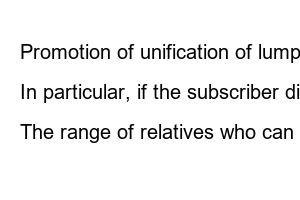국민연금 반환일시금 지급대상According to the Ministry of Health and Welfare (Ministry of Health and Welfare) and the National Pension Service on the 1st, the recently released 5th National Pension Comprehensive Plan contains a policy to revise the national pension lump sum system. The Ministry of Health and Welfare said, “The lump-sum payment system that is paid when a subscriber or beneficiary dies and does not meet certain conditions and do not receive survivor’s pension is complex, and in a situation where household structure is changing, such as the number of single-person households, there are voices calling for improvement of the system. “It reflects,” he explained.
The national pension is a retirement income security system implemented by the government. If the subscriber pays premiums for at least 10 years (120 months) until the age of 59, he or she can receive a pension like a monthly salary from the time he or she reaches the pension age until death.
However, the situation changes when the subscriber or beneficiary dies. In order to settle the insurance premiums paid and provide funeral assistance, only a lump sum is paid to the ‘survivors’ separately defined by the National Pension Act and to a wider range of ‘relatives’. The lump sum payment related to death is divided into a lump sum death payment and a lump sum refund depending on whether the survivor’s requirements under the National Pension Act are met. In the case of death-related lump sum payments, a total of 78.6 billion won was paid to 15,834 people as of 2022.
Promotion of unification of lump-sum death payment and lump-sum refund system
A lump sum refund is available when a subscriber or former subscriber (hereinafter referred to as subscriber) fails to complete the minimum subscription period of 10 years, reaches the mandatory national pension subscription age of 60, or no longer maintains national pension eligibility due to death, loss of nationality, or emigration. If you fail to meet the pension eligibility requirements, the benefit is paid in a lump sum with interest added to the premiums you have paid.
In particular, if the subscriber dies but is not eligible for the survivor’s pension, the lump sum refund is paid according to the scope and order of the survivor as separately determined by the National Pension Act. Spouse, children (under 25 years of age or disabled level 2 or higher), parents (age 61 or older or disabled level 2 or higher), grandchildren (under 19 years old or disabled level 2 or higher), grandparents (age 61 or older) , or disability level 2 or higher), etc.
The lump-sum death benefit is a benefit in the nature of funeral assistance and compensation paid to a wider range of surviving family members under the Civil Act when the subscriber or pension beneficiary dies but there is no surviving family member under the National Pension Act, so there is no one to receive not only the surviving family pension but also the lump-sum refund. The amount is approximately four times the average monthly income of the national pension subscriber during the subscription period. If the pension beneficiary dies after June 30, 2021, if the total pension received while alive is less than the lump-sum death payment, the difference between the lump-sum death payment and the total pension already received will be paid.
The range of relatives who can receive a lump-sum death payment is much wider than the lump-sum return payment. It is paid not only to spouses, children, parents, grandchildren, and grandparents, but also to siblings or collateral blood relatives within the fourth degree of descent who were dependent on the deceased for the highest priority. The Ministry of Health and Welfare is reorganizing and unifying the complex lump-sum payment system, which is divided into a lump-sum refund and a lump-sum death payment, and limiting the recipients of lump-sum payments to spouses, immediate ascendants (parents, grandparents, maternal grandparents), and direct descendants (biological children, grandchildren, great-grandchildren). The plan is to improve the death-related benefit system.

